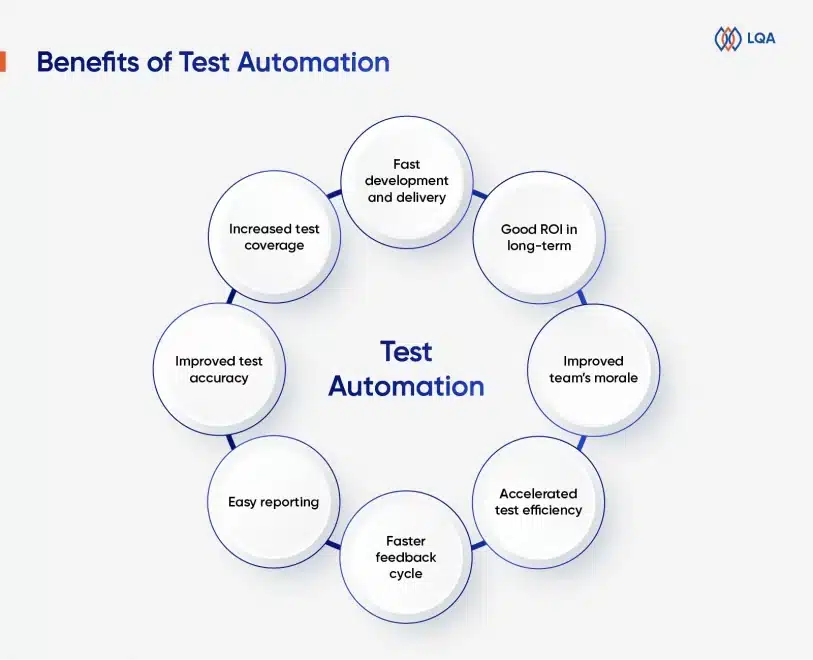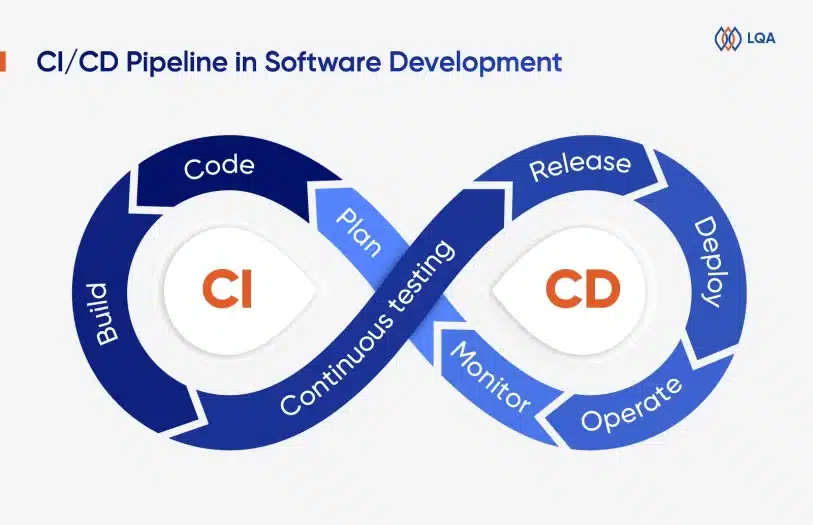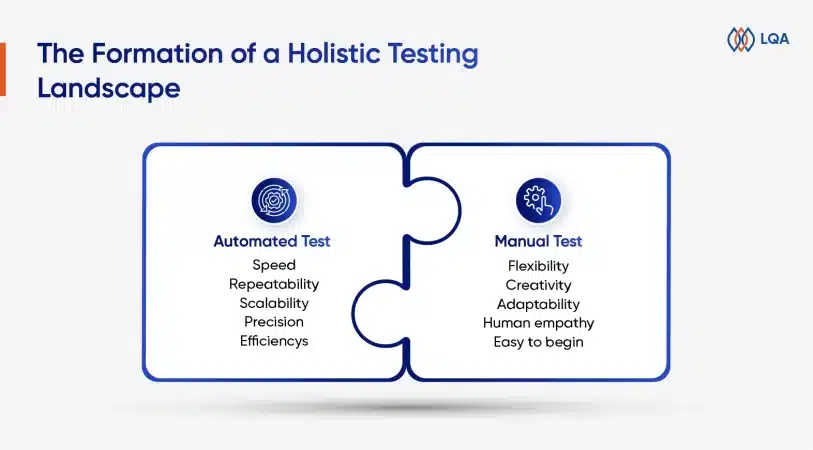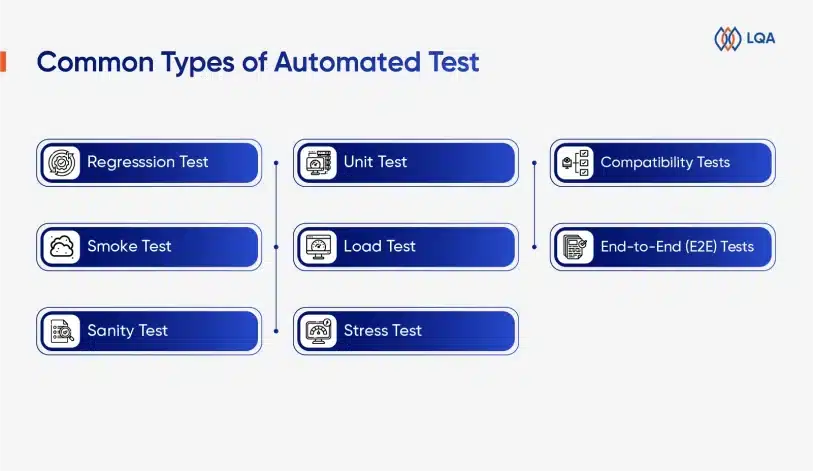Meet LQA’s client, Ted, who owns an F&B chain with 21 brands and 400 restaurants. He deals with approximately 20 mobile and web applications with 5-6 releases for each per year to keep his customers happy.
Testing is a must for Ted. Whenever a new feature graces the scene, he dives into rounds of rigorous tests. And the whole process needs to be swift — perhaps at midnight — to keep his users undisturbed.
Realizing that manual testing seems impractical, Ted turned to LQA’s test automation solutions. And guess what? An impressive 70% reduction in regression test time, all while guaranteeing flawless apps.
That’s just a real example of what test automation can bring to the table. Let’s dig into the top 8 benefits of test automation in this blog.
Top 8 Considerable Benefits of Test Automation

Increased test coverage
Automated software testing can increase the depth and scope of tests, ultimately ensuring software quality and functionality.
Test automation allows the execution of massive complex test cases and lengthy test scenarios across various aspects of the software, covering extensive codebases and different functionalities. Test automation enables the creation of a diverse set of test cases that encompass positive, negative, edge, and boundary test scenarios, ensuring a comprehensive examination of the software.
By running automated tests in parallel and frequently, the development team can attain a higher level of confidence in the application’s functionality and quality.
Improved test accuracy
Unlike manual tests, which are heavily dependent on testers and can be prone to errors, well-written automated test cases follow predefined scripts and perform actions exactly as instructed.
Additionally, automated tests don’t overlook steps or make typos. They also run in a consistent, controlled setup and don’t encounter distractions from subjective and objective factors like humans. From that, automated tests deliver more comprehensive, accurate results and reduce the failure rate of software released to the market.
Easy reporting
In manual testing, reporting can be as cumbersome and monotonous as the test execution itself. It involves constant updates of the test progress, the number of test cases executed, the number of bugs fixed, etc. with a dependency on each other.
With test automation, you can get screenshots, videos, and other formats of reports tailored to specific needs, software areas, and desired reporting frequencies.
Fast development and delivery
If you want to adopt a CI/CD (Continuous integration & Continuous delivery) approach in software development, automating testing is essential.

Test automation at the heart of a CI/CD Pipeline
Typical components for CI/CD include
- agile methodology,
- continuous testing,
- build automation,
- deployment automation, etc.
During such a continuous cycle, you would want to have instant testing throughout your software development life cycle (SDLC) instead of many “pauses” with manual testing.
Here’s a practical example: One of our clients in the food & beverage (F&B) industry saw an impressive 70% reduction in regression test time after implementing custom test automation solutions developed by LQA’s expert automation testing team.
Apart from CI/CD adoption, test automation enables your team to spend less time testing and getting reports on newly developed features, as everything is automated.
Hence, continuous testing achieved by QA automation helps you to bring your product to market faster and gain competitiveness in a fast-evolving technology space.
Faster feedback cycle
Speeding up the feedback cycle is among the core benefits of test automation in agile development. With test execution and report generation automated, testers can provide feedback about the software to developers faster and more regularly, and then the developers can fix the bugs right in the early stages.
By speeding up the feedback cycle, businesses can ensure the product’s time-to-market, minimize bug-fixing resources, and eliminate the risks of launching poor software.
Test efficiency enhancement
Automated software testing can achieve many things that manual testing struggles to deliver, and vice versa. In the case of test automation benefits, it makes many test variants much easier and more potent, such as:
- Regression tests: Whenever a new feature is added, you can quickly rerun a vast number of test cases to ensure that the new updates haven’t adversely affected the existing functionalities.
- Smoke tests: Automated smoke tests align well with the principles of CI/CD by providing rapid build validation of the software after each change.
- Stress tests: When you aim to assess your application’s scalability, employing test automation tools to simulate thousands of concurrent users will be much more cost-effective than manual solutions.
The team’s morale improvement
QA automation can significantly boost team morale by alleviating repetitive and mundane testing and reporting tasks. When teams are freed from the monotonous aspects of testing, they can redirect their energy and creativity toward more engaging and strategic activities, and finally, pass those gains on to their organization.
For instance, consider a scenario where a QA team, burdened with repetitive manual regression tests after each code update, starts leveraging automation. As automated tests take over the routine checks, the team is now able to focus on exploratory testing, innovative test case design, and improve the overall testing strategy.

Good ROI in the long run
Test automation can require a relative initial investment, but it brings substantial cost benefits in the long term. The ROI of test automation is driven by:
- Unbounding productivity
- Reducing meantime
- Enabling reusability of test cases and test scripts
- Reducing the failure rate of software released to the market.
During development cycles, when source code undergoes modifications, automated tests can be executed unattended 24/7 to make the deployment process smoother, safer, and faster. Test cases and scripts are also reusable for similar scenarios, various software versions, and diverse data sets.
Also, test automation enhances test coverage and accuracy, leading to a lower failure rate upon software release. Therefore, software products reach end-users with fewer defects, enhancing customer satisfaction and minimizing the resources required for post-release support and maintenance.
Regarding the cost comparison between the two types of testing methods, check out the breakdowns of automation testing vs. manual testing – which is the cost-effective solution for your firm?
These factors facilitate quality software with fewer development and testing resources, translating into a high return on investment for businesses.
Also read this: 5 automation testing challenges and optimal solutions
Test Automation Fundamentals
What is test automation?
Automation testing is a testing technique utilizing automated testing tools and test scripts to automate testing efforts. In other words, specified and customized tools are implemented in the testing process instead of solely manual forces.
Test automation doesn’t imply automating the entire testing process. Such steps like requirements analysis, test planning, and test case design are done manually before a test automation engineer programs the test script and automates test execution and reporting.
Automated tests, combined with manual tests, form a comprehensive software testing solution. The combination of manual and automated testing bridges the gap between these two approaches, leveraging the strengths of each while eliminating weaknesses.
Learn more about the differences between manual testing vs. automation testing.

The Formation of a Holistic Testing Landscape
What kind of test can be automated?
Several types of tests can be automated. The decision on which tests to automate hinges on the alignment between the benefits of automated testing and project needs, timelines, and the software’s critical aspects, and so on.
Types of software testing to be automated include:
- Unit testing: Testing individual units or components of the software in isolation.
- Regression testing: Ensuring new changes don’t adversely affect existing functionalities.
- Sanity testing: Evaluating whether the basic functionality of a new software build is working correctly or not
- Functional testing: Validating specific functions of the software meet requirements.
- Integration testing: Validating the interaction between software components.
- Performance testing: Assessing the software’s performance under various conditions.
- Load testing: Evaluating how the software performs under expected load conditions.
- Stress testing: Assessing the software’s robustness under extreme conditions.
- Smoke testing: Checking basic functionalities to determine if a build is stable enough for further testing.
- Acceptance testing: Confirming whether the software meets the acceptance criteria.
- Compatibility testing: Verifying the software’s compatibility with different devices, browsers, or operating systems.
- Security testing: Checking for vulnerabilities and ensuring data security.
- Usability testing: Evaluating the software’s user-friendliness and overall user experience.

At LQA – one of the outstanding automation testing companies worldwide, our clients love to automate regression tests, smoke tests, unit tests and sanity tests the most.
The transition from manual to automated testing
Manual testing has been a cornerstone of software quality assurance for decades, offering a hands-on, exploratory approach to testing and allowing for creativity, adaptability, and human intuition.
However, manual tests can be time-consuming, prone to human error, and challenging to scale. This is where automated testing comes in to bring speed, repeatability, and scalability to the testing process.
So, how do you do it – transition from manual testing to automated testing?
- Assessment: Evaluate the current testing processes and identify areas where automation can bring significant benefits.
- Selecting tools: Choose appropriate automation tools and automation frameworks based on your project requirements, technology stack, and budget.
- Training: Train the testing team in the selected automation tools and frameworks to ensure effective utilization.
- Starting with small pilots: Begin by automating simple, repetitive tests to gain confidence and experience.
- Gradual transition: Gradually expand automation coverage as the automation solution stabilizes and the team gains proficiency.
Frequently Asked Questions about Automated Testing Benefits
What are the benefits of using a test automation tool?
An automation testing tool is software that enables you to define testing tasks and then automatically execute those tests, essentially enabling test automation. Automation testing tools encompass both existing tools like Selenium, Appium, and custom in-house developed tools.
So, what are the benefits of test automation framework?
- Fast development and delivery
- Increased test coverage
- Improved test accuracy
- Easy reporting
- Faster feedback cycle
- Accelerated test efficiency
- Improved team’s morale
- Good ROI in long term
What are the benefits of test automation in agile development?
Agile methodology in software development aims to constantly elevate the software until it reaches a product-market fit. During an agile SDLC, new features or improvements are constantly added, and automated tests instantly verify if these increments fit the existing codebase.
Particularly, when agile methodology is integrated with CI/CD practices to automate the process of moving code through the stages of development → testing → deployment, test automation plays a vital role in enabling continuous testing within this streamlined CI/CD pipeline.
Final Thoughts on Enormous Benefits of Test Automation
Despite some challenges like relative initial investment and scripting demands, the substantial benefits of test automation are indisputable, which are speed, accuracy, and high returns in software testing.
In synergy with manual testing, automation forms a comprehensive test solution, guaranteeing a holistic approach that combines human insights and automated precision. This blend optimizes software testing efforts, making it efficient and thorough.
Get To Know LQA
LQA is Vietnam’s 1st independent software quality assurance service provider. We have a presence in Vietnam, Japan & the United States to completely fulfill clients’ demands for QA across industries and geographical locations. During the years of operation, LQA has developed our experience towards industry specialization and become the leading software testing company in Vietnam.
Are you seeking a reliable QA partner? Leave us a message and see how we can help you achieve your business goals.


